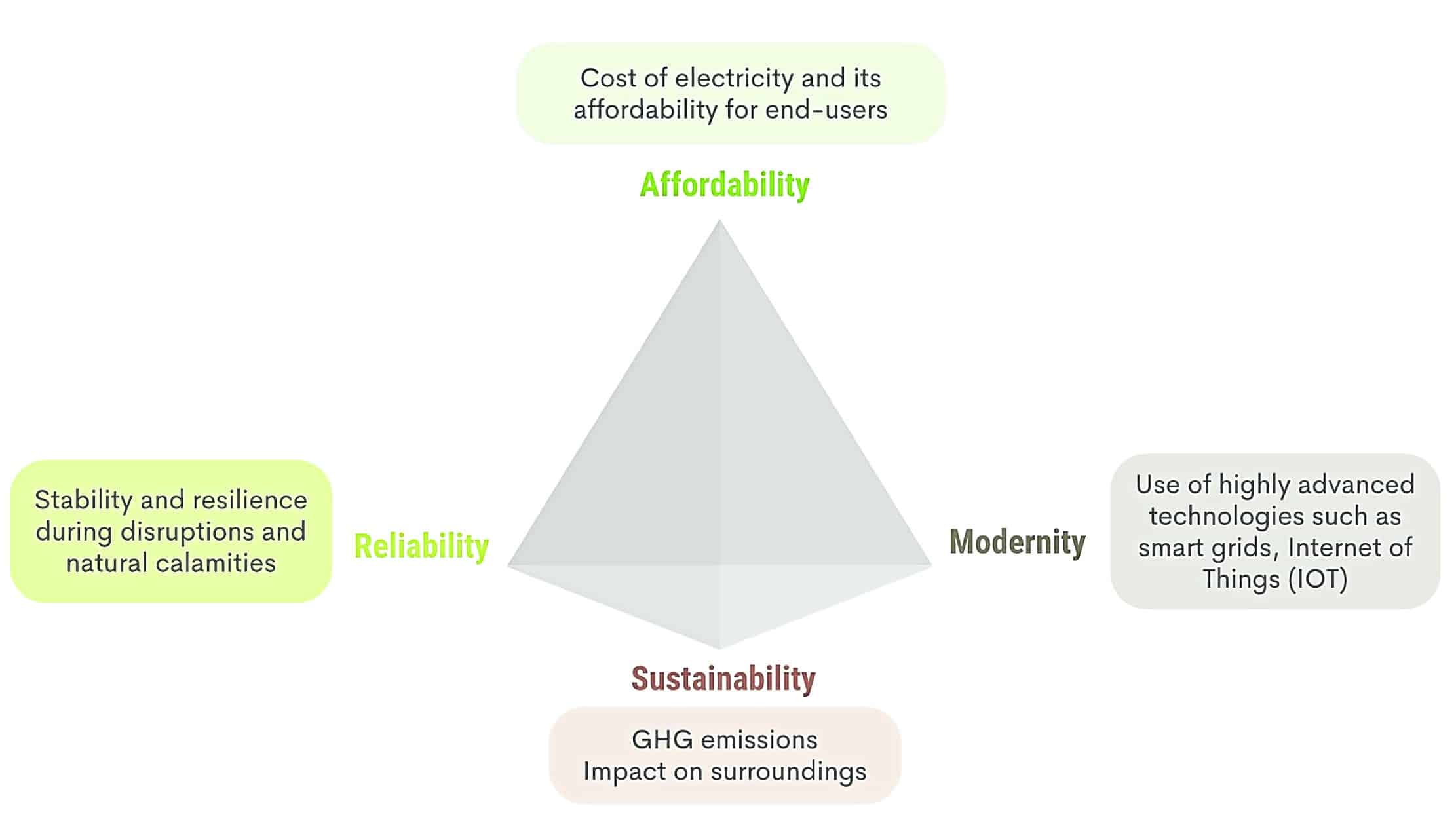Tripping the line: How do we balance PH energy challenges?

PUSH AND PULL The “Unfortunate Tetrahedron”—representing the complex interplay of energy affordability, reliability, modernity, and sustainability that the Philippines has to grapple with. —Contributed graphic
MANILA, Philippines — The Philippines’ energy landscape stands at a critical juncture, grappling with what I call the “Unfortunate Tetrahedron”—the complex interplay of energy affordability, reliability, modernity, and sustainability.
Recent events have thrown these challenges into sharp relief, underscoring the urgent need for a comprehensive approach to our energy future.
Imagine a tetrahedron, a three-dimensional shape with four corners, each representing a crucial aspect of our energy system: affordability, reliability, sustainability, and modernity. This conceptual framework illustrates the difficult balancing act we face in energy planning. Improving one corner often affects the others, and navigating these dynamics requires careful, strategic decisions.
Consider the recent crisis on April 16, 2024, when the Luzon grid was placed under red alert. The National Grid Corporation of the Philippines reported that 19 power plants simultaneously shut down, with three others operating at reduced capacity. This led to a precarious situation where available capacity (13,537 MW) barely exceeded peak demand (13,024 MW).
Reliability, sustainability
This event highlighted the fragility of our current energy system and the consequences of neglecting any corner of the tetrahedron.
The April 16 incident underscores the challenge of maintaining a reliable grid while pushing for greener, more sustainable energy sources. As we aim for 50 percent renewable energy by 2040 as outlined in the Department of Energy’s Philippine Energy Plan, we must ensure our grid remains resilient. The failure of multiple power plants highlights the need for infrastructure that can support the intermittency of renewable energy sources while ensuring grid stability.
The Center for Energy Research and Policy has rightly called for stricter regulation and a thorough investigation into the causes of this incident. As part of this think tank, I emphasize the importance of accountability in the energy sector, advocating for the Energy Regulatory Commission to enforce stricter standards and consider penalties for noncompliance. This ensures that as we move toward sustainability, we do not compromise the reliability of our energy systems.
Building a technologically advanced grid—through smart grids, energy storage, and advanced monitoring systems—requires substantial investments. Yet, events like the April crisis underscore the even higher cost of inaction. Short-term fixes, such as Meralco’s Interruptible Load Program (ILP), where large consumers like shopping malls switch to their own generators during peak demand, may help in emergencies. However, they are not sustainable long-term solutions.
We need to invest in more robust, flexible systems that can handle the variability of renewable sources and the changing patterns of electricity use.
The path to modernization must be balanced with affordability. The implementation of advanced technologies will drive up initial costs, but the long-term benefits—such as reduced grid instability and increased energy efficiency—far outweigh the immediate expenses. It is a necessary investment in the future resilience of our energy infrastructure.
Flexibility and collaboration
To navigate this complex energy landscape, we must prioritize flexibility in our energy systems. This includes:
- Flexible power generation: Developing power plants that can quickly ramp up or down to complement renewable sources.
- Network interconnections: Strengthening grid connections between regions to balance supply and demand across larger areas.
- Demand-side response: Implementing smart technologies that can adjust consumption based on grid conditions.
- Energy storage: Investing in large-scale storage solutions (from short to long duration) to smooth out the variability of renewable energy sources.
These solutions, while requiring substantial investments, are crucial for creating a resilient energy system capable of supporting both renewable integration and the growing demands of an electrified future.
Moreover, this energy transition cannot be achieved in isolation. It demands unprecedented collaboration across sectors—government, industry, academia, financial institutions, and civil society. Together, we can build an energy system that is cleaner, more reliable, and capable of supporting the Philippines’ economic growth while improving the quality of life for all Filipinos.
The recent Luzon grid crisis serves as a wake-up call. It highlights the need for transparency, accountability, and proactive planning in our energy sector. As we move forward, we must harness the power of this energy nexus—the intersection of technology, policy, and sustainability—to build a brighter, more resilient future for the Philippines.
Our journey through the “Unfortunate Tetrahedron” will not be easy, but with careful planning, investment, and collaboration, we can create an energy landscape that serves all Filipinos today and for generations to come.
Joey D. Ocon, Ph.D., is an engineering professor and scientist at the University of the Philippines Diliman whose research covers energy, technology, policy, and sustainability. He is the author of over a hundred publications in international journals; a mentor to over 50 MS and Ph.D. graduates and students; a cofounder of a battery technology startup; a coconvener of an independent energy think tank; and a consultant for government and the industry, bridging the gap between science and technology, innovation, and real-world implementation.